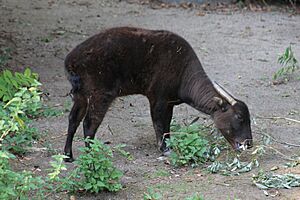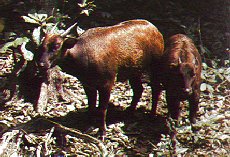Mountain anoa facts for kids
Quick facts for kids Mountain anoa |
|
|---|---|
 |
|
| Mountain anoa (B. quarlesi) at the Krefeld Zoo, Krefeld, Germany | |
| Conservation status | |
| Scientific classification | |
| Genus: |
Bubalus
|
| Species: |
quarlesi
|
| Synonyms | |
|
Anoa quarlesi |
|
The mountain anoa (Bubalus quarlesi), also called Quarle's anoa, is a type of buffalo. It lives only on the island of Sulawesi in Indonesia. It is very closely related to the lowland anoa. Scientists are still debating if these two are actually different species or just types of the same one. The mountain anoa is also related to the larger water buffalo. Both are part of the Bubalus animal group.
Contents
What is a Mountain Anoa?
Scientists group animals together based on how they are related. This is called taxonomy. It can be tricky to tell the difference between the mountain anoa and the lowland anoa. Even their skulls look very similar. Sometimes, these two types of anoa have even bred together in zoos.
For a while, people wondered if they were truly separate species. This is because they live in many of the same places. However, a study looked at the DNA of ten anoa. This study found enough differences to suggest they are indeed two distinct species. An extinct buffalo called Bubalus grovesi from southern Sulawesi was also a close relative.
Appearance and Habits
The mountain anoa is the smallest living wild cattle. It stands only about 70 cm (28 in) tall at the shoulder. This makes it even a little smaller than the lowland anoa. Both types of anoa usually weigh between 150–300 kg (330–660 lb).
Mountain anoa have longer, woollier hair than lowland anoa. This hair sheds every year. You might see faint spots on their head, neck, and legs. They sometimes have white markings on their face and legs too. Their horns are round when you look at them from the end. They look a lot like tiny water buffalo!
Both mountain and lowland anoa live on the island of Sulawesi. They also live on the nearby island of Buton in Indonesia. They prefer to live in quiet, undisturbed rainforests. Unlike most cattle, anoa usually live alone or in pairs. They don't form big herds. The only time you might see more together is when a mother is about to have a baby.
An Anoa's Life Cycle
Not much is known about the anoa's life in the wild. However, anoa living in zoos can live for 20 to 30 years. They become old enough to have babies when they are two or three years old. A female anoa usually has one calf each year. It is very rare for them to have more than one baby at a time.
Why Anoa Are Endangered
Both types of anoa have been considered endangered since the 1960s. Their numbers continue to drop. There are likely fewer than 5,000 of each species left.
There are two main reasons why anoa numbers are shrinking:
- Hunting: Local people hunt anoa for their hides, horns, and meat. This is currently the biggest problem in most areas.
- Habitat Loss: Anoa are losing their homes because people are building more settlements. Also, logging is a big issue. Anoa prefer to live deep inside forests, far away from humans. When trees are cut down, their forest homes get broken up into smaller pieces. This makes it harder for anoa to find safe places to live and breed. It also stops different groups of anoa from mixing, which can reduce their genetic diversity over time.



